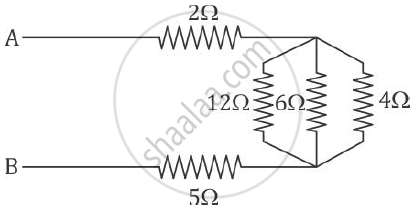Advertisements
Advertisements
Question
If two resistors of 25 Ω and 15 Ω are joined together in series and then placed in parallel with a 40 Ω resistor, the effective resistance of the combination is :
(a) 0.1 Ω
(b) 10 Ω
(c) 20 Ω
(d)40 Ω
Solution
(c) 20 Ω
When 25 Ω and 15 Ω are connected in series, then:
Total resistance, R = 25 + 15 = 40 Î
This 40 Î is connected in parallel with the 40 Î resistor.
Therefore, the net resistance = 40 / 2 = 20 Î
APPEARS IN
RELATED QUESTIONS
Find the equivalent resistance between points A and B.

You are supplied with a number of 100 Ω resistors. How could you combine some of these resistors to make a 250 Ω resistor?
Choose the correct alternative and rewrite the following sentence.
If three resistors 2 ohms, 3 ohms and 4 ohms are connected in series, then the effective resistance in the circuit will be _______ ohms.
Choose the correct alternative and rewrite the following:
You are given three equal resistances. In how many combinations can they are arranged?
Why are thick copper wires used as connecting wires?
2Ω resistor A, 1Ω resistor B and 4Ω resistor C are connected in parallel. The combination is connected across a 2V battery of negligible resistance. Draw the diagram of the arrangement and calculate:
(i) The current in each resistor A and C,
(ii) The current through battery.
Two wires of the same length and area made of two materials of resistivity ρ1 and ρ2 are connected in series to a source of potential V. The equivalent resistivity for the same area is:
What is the maximum resistance which can be made using five resistors each of `1/5` W?
